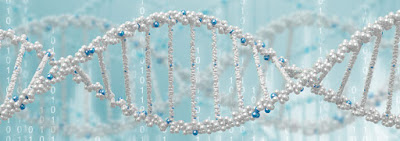....for I am fearfully and wonderfully made: Psalm 139:14
"The evolutionary solution proposes that an end-to-end fusion of two small ape-like chromosomes (named 2A and 2B) produced human chromosome 2. The concept of a fusion first came about in 1982 when scientists examined the similarities of human and ape chromosomes under a microscope.
The first actual DNA signature of a possible fusion event was discovered in 1991 on human chromosome number 2.
Researchers found a small, muddled cluster of telomere-like end sequences that vaguely resembled a possible fusion.
Telomeres are a six-base sequence of the DNA letters TTAGGG repeated over and over again at the ends of chromosomes.
However, the fusion signature was somewhat of an enigma based on the real fusions that occasionally occur in nature.
All documented fusions in living animals involve a specific type of sequence called satellite DNA (satDNA) located in chromosomes and found in breakages and fusions.
---The fusion signature on human chromosome 2 was missing this telltale satDNA.
---Another problem is the small size of the fusion site, which is only 798 DNA letters long. Telomere sequences at the ends of chromosomes are 5,000 to 15,000 bases long.
---If two chromosomes had fused, you should see a fused telomere signature of 10,000 to 30,000 bases long—not 798.
Most genes in plants and animals have their coding segments in pieces called exons so they can be alternatively spliced. Based on the addition or exclusion of exons, genes can produce a variety of products. The intervening regions between exons are called introns, which often contain a variety of signals and switches that control gene function. The alleged fusion site is positioned inside the first intron of the DDX11L2 gene.
The DNA molecule is double-stranded, with a plus strand and a
minus strand. It was engineered this way to maximize information density while also increasing efficiency and function. As a result, there are genes running in different directions on the opposing strands. As it turns out, the DDX11L2 gene is encoded on the minus strand. Because genes in humans are like Swiss army knives and can produce a variety of RNAs, in the case of the DDX11L2 gene it produces short variants consisting of two exons and long variants with three.
Q: What might this DDX11L2 gene be doing?
A: ...it’s expressed in at least 255 different cell or tissue types.
It’s also co-expressed (turned on at the same time) with a variety of other genes and is connected to processes associated with cell signaling in the extracellular matrix and blood cell production.
---The location of the so-called fusion sequence inside a functional gene associated with the genetics of a variety of cellular processes strongly refutes the idea that it’s the accidental byproduct of a head-to-head telomeric fusion.
---Genes are not formed by catastrophic chromosomal fusions!"
ICR
"The evolutionary solution proposes that an end-to-end fusion of two small ape-like chromosomes (named 2A and 2B) produced human chromosome 2. The concept of a fusion first came about in 1982 when scientists examined the similarities of human and ape chromosomes under a microscope.
The first actual DNA signature of a possible fusion event was discovered in 1991 on human chromosome number 2.
Researchers found a small, muddled cluster of telomere-like end sequences that vaguely resembled a possible fusion.
Telomeres are a six-base sequence of the DNA letters TTAGGG repeated over and over again at the ends of chromosomes.
However, the fusion signature was somewhat of an enigma based on the real fusions that occasionally occur in nature.
All documented fusions in living animals involve a specific type of sequence called satellite DNA (satDNA) located in chromosomes and found in breakages and fusions.
---The fusion signature on human chromosome 2 was missing this telltale satDNA.
---Another problem is the small size of the fusion site, which is only 798 DNA letters long. Telomere sequences at the ends of chromosomes are 5,000 to 15,000 bases long.
---If two chromosomes had fused, you should see a fused telomere signature of 10,000 to 30,000 bases long—not 798.
Most genes in plants and animals have their coding segments in pieces called exons so they can be alternatively spliced. Based on the addition or exclusion of exons, genes can produce a variety of products. The intervening regions between exons are called introns, which often contain a variety of signals and switches that control gene function. The alleged fusion site is positioned inside the first intron of the DDX11L2 gene.
The DNA molecule is double-stranded, with a plus strand and a
minus strand. It was engineered this way to maximize information density while also increasing efficiency and function. As a result, there are genes running in different directions on the opposing strands. As it turns out, the DDX11L2 gene is encoded on the minus strand. Because genes in humans are like Swiss army knives and can produce a variety of RNAs, in the case of the DDX11L2 gene it produces short variants consisting of two exons and long variants with three.
Q: What might this DDX11L2 gene be doing?
A: ...it’s expressed in at least 255 different cell or tissue types.
It’s also co-expressed (turned on at the same time) with a variety of other genes and is connected to processes associated with cell signaling in the extracellular matrix and blood cell production.
---The location of the so-called fusion sequence inside a functional gene associated with the genetics of a variety of cellular processes strongly refutes the idea that it’s the accidental byproduct of a head-to-head telomeric fusion.
---Genes are not formed by catastrophic chromosomal fusions!"
ICR


